Campus des Nations, through the implementation of the Primary Years Programme
(PYP), recognises that language, our major means of thinking and communicating,
is fundamental to learning, underpinning and permeating the whole curriculum.
It is not only learning language but also learning about language and through
language and we should nurture an appreciation of the richness of language,
including a love of literature.
Language traditionally has been treated in a fragmented way, with separation
of the strands within language from other areas of the curriculum. The PYP
approach to language seeks to lessen this fragmentation. While the four
communication strands of oral, reading,
writing and visual communication
can be observed separately, they are interrelated and interactive, with
learning in one area supporting learning in another. This is of particular
relevance for international schools, where every teacher is a language teacher.
The PYP considers language from the points of view of class teachers, teachers
of the language of instruction (often EAL/ESL), teachers of other languages
(often the host country language) and teachers of mother tongue languages.
The student outcomes identified by the PYP apply to each student in every
language taught, although the means and pace of teaching them will differ
in different contexts.
Language does much more than promote cognitive growth: the PYP believes
that mother tongue language development is crucial for maintaining cultural
identity and emotional stability and that acquisition of more than one language
enriches personal growth and helps facilitate international understanding.
International schools have a special responsibility to recognise and support
each and every aspect of language development.
| Oral
Communication:
Listening and Speaking |
Visual
Communication:
Viewing and Presenting
|
| Oral
communication encompasses all aspects of listening and speaking,
skills that are essential for language development, for learning,
and for relating to others.
Listening involves listening to people and to texts for general
and precise meaning. Students need to learn how to listen attentively,
to understand and evaluate what they hear, to think about both literal
and inferred meanings, and to respond appropriately.
Speaking involves the pronunciation, intonation and stress of speech;
vocabulary development; communicative competence; the use of grammar;
and the speaker’s fluency and accuracy. Oral language is used
to communicate, reflect, gather, process and present information.
Talk in the classroom is fundamental to promoting language learning.
It also provides immediate feedback, enabling students to reflect
on and evaluate their present level of understanding.
Respect for differences between languages and between dialects is
an important part of oral development in this increasingly global
world. |
Acquiring
skills related to advanced technology and media is necessary because
of their persuasive influence in society. It is important to learn
how media images construct reality by influencing meaning and producing
powerful associations that influence the way we think and feel.
Learning to understand and use different media expands the sources
of information and expressive abilities of students. |
| |
|
| Written
Communication:
Reading |
Written
Communication:
Writing |
We
read for enjoyment, instruction and information. Reading helps us
to understand and clarify our ideas, feelings, thoughts and opinions.
Literature in particular offers us a means of understanding ourselves
and others and has the power to influence and structure thinking.
Students in Class One will be introduced to a wide range of fiction
and non-fiction texts, and have opportunities to read for their
own interest, pleasure and for information. Reading is gaining meaning
from text. The process of reading is interactive and involves the
reader’s purpose for reading, the reader’s prior knowledge
and experience, and the text itself.
The beginner reader must learn about direction, spacing, punctuation
cues and about the general features of text. Students in Class One
will be introduced to the integration and application of semantic
cues (meaning), syntactic cues (structure), and graphophonic cues
(sound-symbol relationships) to establish effective reading strategies
(eg. using picture cues, context cues, prediction, phonics, sight
vocabulary, punctuation, syntax) to help them become independent
readers.
Class One students will also learn how to understand, interpret
and respond to the ideas, attitudes and feelings expressed in various
texts; to think critically about what they read; and to be able
to make predictions and inferences based on information that is
both explicit and implicit in a text.
|
Writing
helps us make sense of the world. It is a powerful means by which
to remember, develop, organize, gain self-knowledge and communicate
ideas, feelings, and information. Purpose and audience contribute
to the form and substance of writing as well as to its style and
tone.
Learning to write is a developmental process and students need to
be able to focus at first on meaning rather than accuracy. Grammar,
spelling, handwriting, punctuation and paragraphing are taught gradually
through writing practice.
The writing process relies on an environment where students are
encouraged to take risks and work co-operatively to achieve written
products for a variety of purposes. The written product can be formal,
informal, personal or reflective. |
These are
the expectations for each year group in Language Arts
| Jump
to the expectations for Early Childhood
Year 1 Year
2 Year 3
Year 4 Year
5 Year 6 |
|
Oral
Communication:
Listening and Speaking |
Visual
Communication:
Viewing and Presenting
|
Written
Communication:
Reading |
Written
Communication:
Writing |
The
students in
Early
childhood
will: |
Begin
to listen in small or large groups for increasing periods of time
Speak clearly in order to be understood
Appreciate and relate to different voice tones
Realize the power language has to fulfil their needs, gain information,
express feelings etc.
Use language to connect new experiences to what they already know
Use language in imaginative and dramatic play, discussions and conversations
Listen to and respond to stories, poems, rhymes, questions and explanations
Begin to anticipate and predict when listening to texts read aloud
Talk about their stories, poems, rhymes, songs, instructions and
explanations
Listen effectively in order to retell, sequence events and describe
past events
Listen effectively in order to follow instructions
Ask questions and give appropriate answers
Distinguish between sounds they hear in their immediate environment
Begin to identify differences in letter sounds
Begin to distinguish the beginning and ending sounds of words
Use appropriate word order in simple sentences
|
Play,
experiment, talk about and relate to different media materials
Use media to make sense of their world
Recognize, name and label a range of familiar media (e.g. advertising,
logos, labels, signs)
View and react to simple messages or factual information and describe
what the see.
Compare media representations to real and/or story versions by drawing
on personal experience or knowledge
Tell the difference between real and animated objects or images

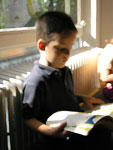
|
Understand
that print has meaning
Begin to discriminate between letters, numbers, symbols and words
Read familiar print from their immediate environment
Recognize their own and other familiar names
Participate in shared reading, guided reading and read-aloud situations
Read simple, familiar texts
Demonstrate awareness of some conventions of written text (e.g.
spaces between words, directionality)
Demonstrate conventional book handling skills
Select and reread favourite texts for enjoyment
Use a variety of strategies to unlock text (e.g. prior knowledge,
visual, contextual and memory cues)
Recognize the beginning, middle and end of a story
Retell a story or experience
Make predictions at the beginning, during and at the end of texts
Make links between personal experiences and storybook characters
Begin to show an awareness and understanding of sound-symbol relationships
Recognize and name some of the letters of the alphabet and their
sounds
Begin to match spoken word(s) to written word(s)
Begin to recognize the beginning and end sounds or letters in familiar
words
Begin to recognize a basic list of common sight words (e.g. is,
and, big, dog, love)
|
Show
interest and curiosity in different models or forms of written text
Write their name
Experiment with print
Differentiate between numbers, letters, symbols and drawings
Show knowledge of the names or sounds of the letters of the alphabet
Attempt to use familiar letters and/or sounds to write a message
Write letters and words and give them meaning
Create illustrations to match their own text
Use simple sentence structures
Demonstrate an awareness of directionality
Attempt to form letters conventionally and legibly
Respond to conventional pencil grip
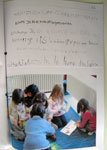
|
|
Oral
Communication:
Listening and Speaking |
Visual
Communication:
Viewing and Presenting |
Written
Communication:
Reading |
Written
Communication:
Writing |
| The
students in
Year
1
will: |
Listen
attentively and considerately and respond in small-and large-group
situations
Use talk to establish relationships with others and for a variety
of personal purposes
Begin to understand that language is influenced by purpose and audience
Hear and accept differences between languages
Participate in imaginative play, storytelling, role play and dramatization
of stories and poems
Listen to and talk about stories, poems, rhymes, questions, explanations
and instructions with increasing confidence and detail
Be able to anticipate and predict when listening to texts read aloud
Express thoughts, feelings, ideas and opinions and be able to discuss
them, respecting contributions from others
Retell, relate and sequence events and stories with increasing detail
Ask questions and give appropriate answers
Hear the beginning, middle and end of words
Use simple and compound sentences, with appropriate word order
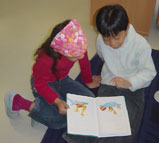
|
Understand
that communication involves visual as well as verbal features
Understand that signs, symbols and icons carry meaning
Begin to make discerning choices about what they see
Begin to interpret visual cues in order to analyse and make inferences
Begin to understand the role of familiar media in their own and
their family’s daily life
Begin to make inferences about what a character could be like by
observing body language, facial expressions, gestures, clothing,
and the way other characters respond to them
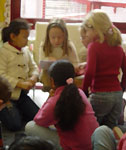
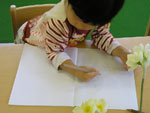
|
Enjoy
reading and being read to
Read for a variety of purposes and respond to what is read
Participate in paired, group or class reading activities
Read and retell simple, familiar books independently with confidence
and will be willing to take risks
Read silently with a degree of independence
Use a variety of reading strategies to make meaning of text
Recognize that a story has a beginning, middle and end
Predict what may happen next in a story and revise or confirm predictions
Identify with a character or a situation
Recall the plot and characters of a story
Understand and respond to the ideas and feelings expressed in various
reading materials
Recognize and talk about a range of different text types (e.g. letters,
lists, recipes, stories, poetry, plays)
Start to develop personal preferences in reading
Understand the role of an author or illustrator
Begin to recognize and use the different parts of a book (title
page, contents page, page numbers, index)
Know the difference between fiction and non-fiction
Begin to use reference books, dictionaries, and computers with some
independence and confidence
Read simple text aloud with expression and with regard to punctuation
Understand sound-symbol relationships and recognize and name all
letters and sounds
Know the alphabet and be able to use simple alphabetical order.
|
Show
confidence and a positive attitude to writing
Write about a range of topics that are personally significant
Write simple, sequenced stories with a beginning, middle and end
Use some simple literary forms and structures
Show some knowledge of, and a willingness to use an appropriate
writing process (planning, drafting, editing, producing)
Respond orally to the work of others
Present writing appropriately with correct directionality and spacing
Begin to use capital letters, full stops and question marks appropriately
Accurately spell some high-frequency words
Use phonetic spelling
Begin to use some common spelling patterns
Use simple and compound sentences
Write legible upper- and lower-case letters in a consistent style
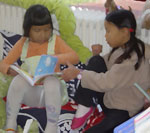

|
|
Oral
Communication:
Listening and Speaking |
Visual
Communication:
Viewing and Presenting |
Written
Communication:
Reading |
Written
Communication:
Writing |
The
students
in
Year 2
will: |
Use
a variety of oral language appropriately with increasing confidence
Express their own thoughts, feelings, ideas and opinions and be
able to
discuss them, respecting contributions from others
Speak clearly and use tone, volume and intonation to enhance meaning
Use talk to establish relationships with others and for a variety
of
personal purposes
Give instructions, directions and messages and respond to the
instructions of others
Ask questions and give appropriate answers
Work in groups and discuss ideas
Retell, relate and sequence events and stories with increasing detail
Begin to understand that language is influenced by purpose and audience
Begin to develop specific vocabulary to suit different purposes,
(e.g. descriptive, comparative or persuasive vocabulary)
Hear and use rhyming words
Use simple and compound sentences
Listen to and talk about stories, poems, rhymes, questions,
explanations and instructions with increasing confidence and detail
Appreciate that listening is important in both large and small groups
Listen attentively and considerately and respond in small and large
group activities
Appreciate and relate to different voice tones
Increase their ability to anticipate and predict when listening
to
texts read aloud
Pick out the main events and relevant points in oral texts
Hear and accept differences in other languages
Hear the beginning, middle and end of words, including blends and
digraphs
|
Understand
that communication involves visual as well as verbal
features
Begin to read a range of signs in the environment and understand
that
signs and symbols carry meaning
Read and use texts with different types of layout
Begin to understand information presented using a range of visual
forms (e.g. computer, television, videos, theatre, etc.)
Search for, record and present information using a variety of media
Begin to make choices about what is relevant and useful to them
Begin to use a range of appropriate technology (i.e. computer, C.D.
Rom, internet, etc.)
Make inferences about what a character could be like by observing
body language, facial expressions, gestures, clothing and the way
other characters respond to them
Begin to interpret information provided in advertisements
Begin to understand the role of familiar media in their family’s
daily life
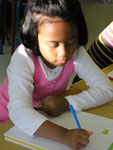
|
Enjoy
reading and being read to
Read simple texts at their level with confidence, pleasure and
increasing fluency
Start to develop a personal preference in reading
Read simple texts aloud with expression and with regard to punctuation
Participate in daily reading for independent and instructional purposes
Use a variety of strategies to decode words
Use a variety of strategies to make meaning of text
Discuss stories heard and read and demonstrate an awareness of
character and plot
Understand and respond to ideas and feelings expressed in a text
Begin to use reference books, dictionaries and computers with some
independence
Recognize that a story has a beginning, middle and end
Predict what may happen next in a story
Recognize and talk about a range of text types (e.g. stories, letters,
lists, etc.)
Know the difference between fiction and non-fiction
Understand the role of the author and illustrator
Recognize and use the different parts of a book (title page, contents
page, page numbers, index etc.)
Begin reading silently with some degree of independence
Know the alphabet and be able to use simple alphabetical order
|
Show
confidence and a positive attitude to writing
Write about a range of topics that are personally significant
Write simple sequenced stories with a beginning, middle and end
Begin to spell high frequency words accurately
Show some knowledge of and a willingness to use an appropriate writing
process (planning, drafting, editing, producing)
Present writing appropriately using correct directionality and spacing
Use capital letters, full stops (periods), and question marks
Accurately spell some high frequency words
Use phonetic spelling
Begin using common spelling patterns
Begin using a simple dictionary or word list to help in spelling
some
high frequency words
Use simple sentences and begin using compound sentences
Write legible letters and recognize the difference between upper
and
lower case letters
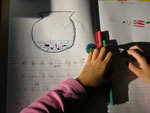
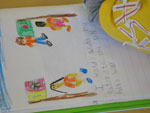
|
|
Oral
Communication:
Listening and Speaking |
Visual
Communication:
Viewing and Presenting |
Written
Communication:
Reading |
Written
Communication:
Writing |
The
students in
Year 3
will: |
Speak
clearly and audibly
Listen responsively and respectfully
Ask appropriate questions to gain information and to maintain or
clarify understanding and respond to the questions of others
Paraphrase and summarize information shared orally by others
Contribute to group discussions
Begin to negotiate to develop a group plan to resolve conflicts
and misunderstandings
Use increasingly complex sentence structures and vocabulary in oral
communication
Give and follow oral directions with three or four steps
Participate in choral reading and recite poems, rhymes, songs, and
stories
Listen appreciatively to stories and poetry and respond to them
Be sensitive to others’ use of language
|
Experience
a wide variety of visual media
Begin to respond to viewing experiences orally and in writing
Begin to explore and use visual communication in order to express
their own ideas and interpret the ideas of others
Begin to demonstrate an awareness of the presence of the media in
their daily lives
Begin to recognise the power of the visual media to influence thinking
and behaviour
Demonstrate an understanding of the basic elements of a poster
Begin to make informed choices about their personal viewing experiences
Begin to use a variety of media to plan and create projects
Begin to use electronic media to search for information
|
Read
a variety of fiction and non-fiction books with increasing confidence,
fluency and independence
Select books appropriate to their reading level and for specific
purposes
Be interested in and show appreciation for variety of literary styles
Understand to ideas, feelings and opinions expressed in reading
material
Use reference materials including information technology with increasing
independence
Read for pleasure daily and for sustained periods
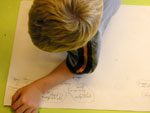
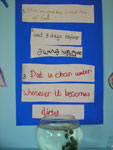
|
Write
more and more independently, with growing confidence and fluency
Use a growing and increasingly vivid vocabulary
Begin to understand constraints of sentence structure, grammar and
punctuation
Write for a range of purposes both creative and informational
Begin to plan edit and review their own writing
Spell high frequency words correctly and use a range of strategies
when spelling more complex words
Write in a consistent legible style

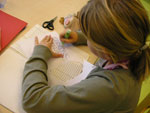
|
|
Oral
Communication:
Listening and Speaking |
Visual
Communication:
Viewing and Presenting |
Written
Communication:
Reading |
Written
Communication:
Writing |
The
students in
Year 4
will: |
Use
oral communication for listening and speaking in a variety of learning
and social situations
Listen attentively to people and to texts for meaning, evaluate
what the hear and respond appropriately
Use correct pronunciation and intonation for vocabulary development,
communication of ideas, grammar and fluency
Use oral communication for gathering information, asking questions,
relating and retelling information in discussion in a range of formal
and informal situations
Explain and discuss their own ideas and written work with peers
and adults
Begin to communicate in more than one language
Use language that is appropriate to the audience and the purpose
in formal and informal situations
Use proper conventions and grammatical structures for oral presentation
and discussion
Begin to argue persuasively to defend a point of view
Begin to paraphrase and summarize information for different purposes
Use more sophisticated storytelling skills that show an awareness
of
structure and expression
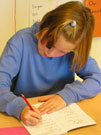
|
Demonstrate
an awareness of the media in the daily life of most people
Demonstrate the basic elements of a poster
Study and interpret a still representation of a landscape (photograph,
painting, model) and identify what is seen, describe the elements
and analyze the representation
Use strategies to identify appropriate resources and find information
in
visual media
Use critical and analytical skills to respond to communication media
Search for, record and present information from a variety of media
and texts
Explore and use visual communication in order to express their own
ideas and interpret the ideas of others
View, analyze and discuss a wide variety of media works and relate
them to their own experiences
Use a range of technologies to create media works of many types
which
combine text and pictures to show a summary of a topic (e.g. cartoons,
designs, video, film animation, web pages, diagrams)
Begin to select the appropriate presentation format for their work
Appreciate form and quality of presentation
|
Read
independently, fluently, accurately and with understanding
Engage in daily individual silent reading with concentration
Use reading for pleasure, instruction and information
Use a wide range of fiction and non-fiction texts and genre
Understand and respond to the ideas, feelings and attitudes in a
variety of texts
Begin to understand the author's purpose to inform, persuade, entertain
or instruct
Make inferences and justify them in oral and written situations
Identify and describe the elements of a story: setting, plot, characters,
theme
Recognize more complex story structure
Read to skim and scan in order to find specific information quickly
Respond to text by identifying the main idea, recognizing cause
and effect,
Distinguishing between fact and opinion, questioning, and drawing
conclusions
Read text aloud with fluency, expression, and with regard to punctuation
Locate, select and use reference books, dictionaries and ICT to
find accurate and relevant information
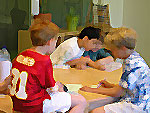
|
Experience
and appreciate different types of writing structures and styles
Use appropriate punctuation to support meaning
Demonstrate an increasing understanding of how and why grammar works
Accurately spell high-frequency and familiar words, use spelling
patterns and a range of strategies to spell words of increasing
complexity
Use content-specific vocabulary related to different subjects and
specific
units of inquiry
Write a descriptive, narrative or information paragraph
Write for a range of purposes, both creative and informational,
for themselves and others
Write in a consistent, legible style
Use word processing to compose written pieces
Write independently with confidence, demonstrating an increasing
Development of an individual 'voice'
Respond to the writing of others with sensitivity and respect
Compose using a range of written structures and styles to reflect
the
particular purpose of the writing
Reread their work in order to make revisions and improve their writing
Begin to use literary devices such as similes, onomatopoeia, and
alliteration
Experiment with composing using different forms of poetry, including
free verse and a variety of poetic structures
|
|
Oral
Communication:
Listening and Speaking |
Visual
Communication:
Viewing and Presenting |
Written
Communication:
Reading |
Written
Communication:
Writing |
The
students in
Year 5
will: |
Use
different forms of appropriate language to communicate to a variety
of audiences
Participate appropriately in complex discussions, conversations,
class and group meetings and group presentations
Listen attentively and considerately to others
enhance meaning using expression, tone and volume
Use an increasing vocabulary and more complex sentence structure
Understand and use a variety of literacy devices
Prepare and deliver personal presentations for a variety of purposes
Prepare and present a point of view, arguing persuasively and begin
to develop debating skills
Participate in role play, story telling, dramatization of stories
and poems
Use appropriate language around school
|
View
appropriately a wide range of visual materials
Identify appropriate resources and find information in visual media
Use a range of methods to create many types of visual
material (e.g.
posters, cartoons, designs, diagrams, maps)
Begin to select appropriate format for the presentation of work
Explore and use visual communication in order to express our own
ideas and to interpret the ideas of others
View, analyse and discuss a wide variety of visual materials
and relate them to own experiences
Show an awareness of the effects of the media in our daily lives
|
Select
books appropriate to their reading level and for a specific purpose
Read a wide range of texts confidently, with understanding and accuracy
Be interested in or show an appreciation of a variety of literary
styles
Respond to ideas feelings and attitudes expressed in written text
Be able to reflect on and analyse details of character and plot
Begin to appreciate authors use of language
Locate and use a variety of reference materials to guide research
Read daily for sustained periods
|
Begin
to write fluently in a range of styles
Use a wide and vivid vocabulary
Begin to match different styles and structures to the task
Write for a range of purposes both creative and informational
Plan, edit and review their own writing
Spell high frequency words accurately and use a range of strategies
to spell complex words
Begin to develop their own voice and style
Write in a consistent legible style
|
|
Oral
Communication:
Listening and Speaking |
Visual
Communication:
Viewing and Presenting |
Written
Communication:
Reading |
Written
Communication:
Writing |
The
students in
Year 6
will: |
Have
an increased awareness of the power of oral communication and how
it helps them construct meaning and connect with others
Begin to use speech responsibly to inform, entertain and influence
others
Understand that oral language is a medium for learning as well as
for individual enjoyment
Begin to use a wide variety of linguistic structures and features
of spoken language to develop and present ideas and information
Adapt their speaking and listening strategies to the context, purpose
and audience
Reflect upon communication to monitor and assess their own learning
|
Demonstrate
appropriate viewing behaviour for a range of visual materials
Respond to viewing experiences orally and in writing, using specific
vocabulary and terminology
Identify stereotypes
Work with a variety of materials to plan and carry out different
projects
Recognize the implications of commercial media
Begin to make informed judgments about television, film and video
productions
|
Read
a wide range of texts with understanding and accuracy
Begin to recognize and appreciate various literary styles, forms
and structures
Appreciate structural and stylistic differences between fiction
and non-fiction
Be able to reflect upon and analyse details of character and plot
Begin to appreciate authors’ use of language and begin to
recognize meaning beyond the literal
Locate and use a range of reference materials to find information
and guide research
Read daily for enjoyment and information, for sustained periods
|
Write
fluently and effectively in a range of styles
Match different styles and structures of writing to the task
Show an awareness of audience
Use relevant and appropriate supporting details and effective vocabulary
Vary sentence structure and length
Use an appropriate writing process independently and confidently
Develop their own voice and style
|

5concepts
| | | | | |
| Demonstrations
of deeper learning in responsible behaviour through positive action and
service; a manifestation in practice of the other essential elements | Powerful
ideas which have relevance within and across the disciplines and which
students must explore and re-explore in order to develop understanding | Significant,
relevant, subject matter which students are expected to explore and know
about Click
here to find out more about
the 6 themes Click
here to find out more
about the 6 subject areas
| Those
things which the students need to be able to do to succeed in a changing,
challenging world | Dispositions
which are expressions of fundamental values, beliefs and feelings about
learning, the environment and people |
|

















